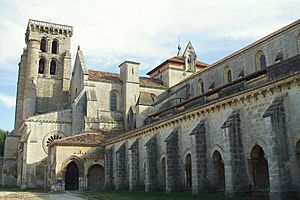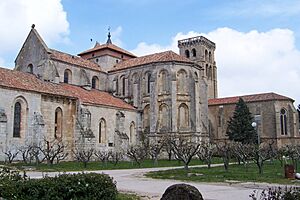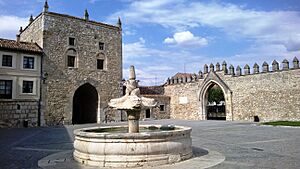Abbey of Santa María la Real de Las Huelgas facts for kids
Quick facts for kids Abbey of Santa María la Real de Las Huelgas |
|
|---|---|
| Native name Spanish: Monasterio de Santa María la Real de Las Huelgas |
|

Façade of the monastery
|
|
| Location | Burgos, Castile and León, Spain |
| Founded | 1187 |
| Built | 12th-13th centuries |
| Architectural style(s) | Romanesque, Almohad, Gothic |
| Governing body | Cistercian nuns |
| Official name: Monasterio de Santa María la Real de las Huelgas | |
| Type | Non-movable |
| Criteria | Monument |
| Designated | June 3, 1931 |
| Reference no. | RI-51-0000453 |
| Lua error in Module:Location_map at line 420: attempt to index field 'wikibase' (a nil value). | |
The Abbey of Santa María la Real de Las Huelgas is a very old monastery where Cistercian nuns live. It is located about 1.5 kilometers west of the city of Burgos in Spain. The word huelgas usually means "strikes" today, but long ago it meant "fallow land" – land left unplanted to rest. This monastery has been a special place for many royal weddings, both for Spanish and foreign kings and queens. For example, Edward I of England married Eleanor of Castile here in 1254. Also, King Peter of Castile was born in the abbey's defensive tower.
Contents
History of the Abbey
How the Monastery Started
The Abbey of Las Huelgas began in 1187. On January 2, Pope Clement III gave permission to create a monastery dedicated to the Virgin Mary. Later that year, King Alfonso VIII of Castile and his wife, Eleanor of England, officially started the monastery. Queen Eleanor was the daughter of Henry II of England and Eleanor of Aquitaine. They decided the monastery would be run by the Cistercian Order of nuns.
Royal Connections and Special Powers
For many centuries, the monastery received special treatment from the king. It didn't have to pay taxes and even controlled many villages and lands. The head nun, called the abbess, governed these areas like a powerful lord. The monastery also owned many valuable religious items from the royal family. It's even said that, for a time, the abbess had special religious powers, similar to a priest, like hearing confessions.
In 1199, the founders officially gave the monastery to the nuns. They also added a rule that the monastery would be the burial place for the royal family. Constance, King Alfonso's youngest daughter, became a Cistercian nun there. She was the first "Lady of Las Huelgas," a special role held by royal women. This showed the close bond between the abbey and the royal family. Queen Eleanor and Queen Berengaria were both known for supporting the abbey. While royal family members were secular leaders, abbesses like Sancha Garcia were the spiritual leaders.
The Royal Hospital
King Alfonso VIII and Queen Eleanor, who were both buried at Las Huelgas, also created the Royal Hospital. This hospital was connected to the abbey and was managed by the abbess. It was built to help and feed poor pilgrims traveling along the Camino de Santiago, a famous pilgrimage route. Queen Eleanor made many donations to the hospital, especially in honor of her son Ferdinand, who had passed away.
A group of lay brothers, who were not priests but dedicated to religious life, formed to help the nuns care for the hospital's patients. They were known as the Brothers Hospitallers of Burgos. There were never many of them, but they became their own religious group in 1474. However, in 1587, their order was stopped, and they were again placed under the abbess's authority.
The Abbess's Authority
The abbess of Las Huelgas was very powerful. The king gave her almost royal rights. She had complete control over more than fifty villages. Like other powerful lords, she held her own courts to decide civil and criminal cases. She could also grant special permissions for priests to be ordained, hear confessions, preach, and provide spiritual care within her territory. She could even confirm other abbesses and call meetings of Cistercian leaders. In 1189, she was made the Abbess General for the Cistercian Order in the Kingdom of León and Castile. This meant she could hold a yearly meeting in Burgos. The abbess kept these special powers until the Council of Trent in the 16th century.
Life at the Abbey Today
Today, about 36 nuns live at the monastery. They are part of the Spanish Congregation of St. Bernard, a group of Cistercian nuns that started in the 16th and 17th centuries. They are sometimes called "Bernadines." These nuns follow the Rule of St. Benedict very strictly, which includes frequent and long fasts. They also celebrate the Divine Office (a set of prayers) very early in the morning, around 2:00 A.M. The nuns earn money by decorating porcelain items, making rosaries, and doing laundry for local hotels.
The abbey has also started a "daughter house" (a new monastery) in Peru. This monastery, called the Monastery of the Most Holy Trinity, is located near Lima Metropolitan Area. It has about ten nuns and several new members training to join. They support themselves by making cakes and jams using fruits and vegetables from their own gardens.
Exploring the Abbey's Treasures
Visiting the Monastery
The Abbey of Las Huelgas is open to visitors. The Spanish heritage organization Patrimonio Nacional manages the property as a Spanish royal site, not the nuns themselves.
Amazing Textiles
The monastery has a museum called the Museo de Ricas Telas (Museum of Rich Fabrics). It displays beautiful medieval textiles taken from the many royal tombs inside the convent. You can also see a special tapestry that once covered the tent of the Almohad caliph Al Nasir, also known as Miramamolin. This tapestry was captured by Christian forces at the Battle of Las Navas de Tolosa on July 16, 1212. When Sancho VII of Navarre's soldiers broke through the caliph's guards, he fled quickly, leaving this tapestry and other valuable items behind.
Musical History
Las Huelgas is home to a very old music book from the 14th century, called the Codex Las Huelgas. It contains both simple (monophonic) and complex (polyphonic) music. It is believed that the nuns performed this music. Some of the songs in this book are not found anywhere else in the world.
Royal Burials
Many important royal figures are buried at the Abbey of Las Huelgas, including:
- Henry I of Castile
- Eleanor of England, Queen of Castile
- Alfonso VIII of Castile
- Berengaria of Castile
- Blanche of Portugal (1259–1321)
- Eleanor of Castile (died 1244)
- Philip of Castile, Lord of Cabrera and Ribera
- Peter of Castile, Lord of Cameros
- Blanche of Castile (1319–75)
Images for kids
-
Monastery of Santa María la Real de las Huelgas by Jenaro Pérez Villaamil and Louis-Julien Jacottet in 1842-1850.
-
Le Monastére de las Huelgas, près Burgos by Gustave Doré in 1874.
-
Chorus's interior of Las Huelgas by Jenaro Pérez Villaamil and Léon-Auguste Asselineau in 1850.
See also
 In Spanish: Monasterio de las Huelgas (Burgos) para niños
In Spanish: Monasterio de las Huelgas (Burgos) para niños








